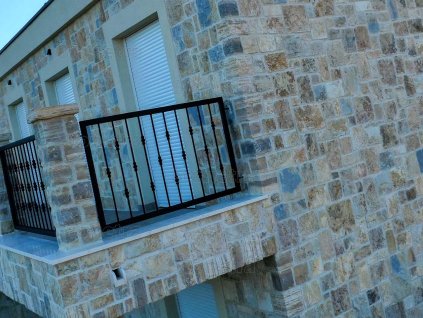Limestone
Limestone is a natural sedimentary stone primarily composed of calcium carbonate. It is valued for its warm, neutral tones ranging from creamy whites and beiges to soft greys and browns, as well as its natural texture and versatility. Limestone has been used for millennia in both structural and decorative applications due to its strength and timeless beauty.
Limestone has a rich architectural history, dating back to ancient civilizations. The Egyptians used limestone extensively for constructing the Pyramids of Giza, while the Romans incorporated it in aqueducts, temples, and public buildings. Over the centuries, limestone has been used in castles, churches, and palaces across Europe and the Middle East, appreciated for its durability and aesthetic appeal.
Modern Uses
Today, limestone remains a popular natural stone for a wide range of applications:
- Flooring: Durable pavers for exteriors.
- Wall Cladding: Feature walls, rock stone veneer, fence cladding and fireplaces.
- Paving: Patio pavers, terraces, walkways, pool surrounds, stepping stones.
- Decorative Elements: Accent walls and TV walls.
- Landscaping rocks: Decorative pebbles and gravel
Limestone’s subtle, natural colors and textures make it suitable for both classic and contemporary designs.
Surface Treatments
- Edges: hand-cut or sawn, depending on the design intent.
Qualities
- Durable: Strong enough for both indoor and outdoor use.
- Natural Beauty: Soft, warm tones create a timeless and elegant aesthetic.
- Eco-Friendly: Natural stone that does not emit harmful chemicals.
- Versatile: Can complement wood, metal, glass, and other natural stones.
- Workability: Can be cut and shaped into tiles, slabs, or decorative elements for various applications.
Care and Maintenance
Limestone is porous and requires proper care to maintain its beauty and durability:
- Sealing: Should be sealed upon installation and periodically resealed to prevent stains and water penetration.
- Cleaning: Use pH-neutral cleaners; avoid acidic or abrasive products that can damage the stone.
- Spill Management: Wipe up spills immediately to prevent staining, especially from oils or acidic substances.
- Protection: Use mats or rugs in high-traffic areas and felt pads under furniture to prevent scratches.
- Polished Surfaces: Require gentle cleaning and occasional polishing to maintain shine.
- Outdoor Use: Ensure proper drainage and regular cleaning to avoid moss, algae, or dirt buildup.
Limestone combines history, elegance, versatility, and durability. From ancient Egyptian pyramids to modern homes and public buildings, it remains a timeless material prized for its natural beauty, wide range of surface finishes, and enduring qualities.

























